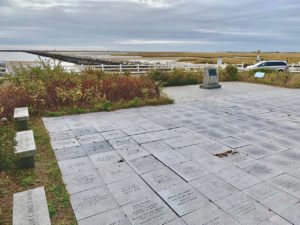PROVINCETOWN — The select board is looking to break the logjam on two projects related to the Provincetown 400 commemorations.
The board voted on Oct. 15 to hire a landscape architect to help improve the Pilgrims’ First Landing Park, inside the rotary at the far end of Commercial Street, near the spot where the Pilgrims are supposed to have first set foot in America.

They also voted to get quotes from a half-dozen specialists on indigenous memorials — consultants who are versed in the complexities of how cities can best honor indigenous people and create public art. In both cases, it is hoped that consultants can provide an informed assessment of options and a proper breakdown of costs.
On the Pilgrims’ First Landing Park, the dept. of public works and the public landscape committee are now reading from the same page. They had offered two different plans, but they now have presented a joint memo outlining a first phase that could be complete by spring 2020, following by phase two. Rich Waldo of the DPW and members of the committee described their respective roles and their hopes for the landscape architect’s help.
Their current focus is on clearing the weed-infested rosa rugosa and trimming trees to open up sight lines to the water and clear space for more appealing plantings in the spring. The committee also proposed working with the historical commission on language for new signs. The landscape consultant will be charged with rearranging the seating areas and pedestrian walkways and considering signs and memorial placements.
The Mayflower Compact is supposed to have been signed near this spot, but the park is also home to a large group of paving stones and benches that commemorate individuals who lived in or loved Provincetown. Integrating these individual markers with a Pilgrim marker and an indigenous marker is a key design challenge the landscape architect will be addressing.
Select board member Lise King read a statement arguing for the importance of recognizing the indigenous people who were living here when the Pilgrims made landfall.
“We have a moral obligation to recognize the impact on those people, families, communities that were here at this time,” said King. “The park contains memorial granite plaques marking the passing of loved ones. We can’t have a bunch of memorial stones and no indigenous memorial stone.”
King proposed that phase one, ready by spring 2020, ought to have some kind of sign, marker, or language honoring native peoples, even if the installation of a more substantial memorial were not happening until phase two.
Later in the select board’s meeting, discussion turned to a request from King to solicit quotes to hire an indigenous public memorial specialist. Efforts to install a Wampanoag memorial at the Bas Relief park have broken down, partly because while the original site considered was at the Pilgrim Monument, which is on private land, an attempt to install that same design on public land raised questions about site location, artistic vision, procurement procedures, and historical justice that accumulated into a thicket of difficulties.
King reported to the board that other cities and towns have faced similar challenges around inclusive remembrance in a municipal context. She said that several nationally known Native American curators, anthropologists, and specialists in public art have begun contracting to help towns work through these subjects.
“It’s such a specific skill set,” said King. “There has to be a background in public art, in memorial building and public art, people who know how to work within the municipal process.”
After some discussion about whether the prior Wampanoag memorial efforts were truly stalled — “the parties who were participating are no longer communicating with us,” King confirmed — the select board voted unanimously to solicit quotes from experts in hopes of bringing their experience to Provincetown’s parks.



